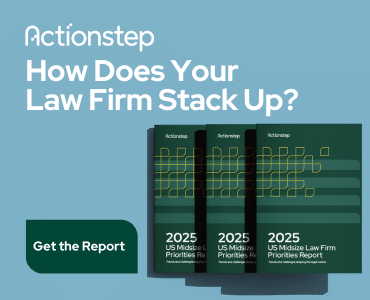Law firm overhead is more than the light bill and rent. It’s also the people with nonbillable time, like your office manager and sales team.

I talk to a lot of law firms about the “Rule of Thirds.” Basically, you divide your revenue into thirds for people, law firm overhead and profit.
- One-third of revenue goes to pay the people doing the work
- One-third of revenue goes to overhead
- One-third of revenue goes to profit
But people often ask me, “What exactly is in law firm overhead?”
Breaking Down Law Firm Overhead Items
There are the easy elements in your overhead: rent, phone, copier rental, research subscriptions, case management software, marketing. All the things that you have to pay for each month, whether you use them or not, that keep the lights on and the doors open to your firm.
When your business is still small, overhead is everything except payroll, taxes and benefits.
But as you grow, the way you look at your people and overhead starts to morph. Once you pass the $1 million mark, and definitely as you hit $2 million, you start to move some salaries out of the people category and put them in overhead. This is because you are becoming a more professionally run business. These are the four you’ll move first.
The Big Four People Expenses to Move to Overhead
1. Marketing Salaries
As you begin to bring marketing in-house, it is time to start moving those salaries out of the people category and put them under “marketing,” a subset of overhead. These are full-time people whose only responsibilities are marketing. I’m not talking about the legal assistant or receptionist you task with doing social media. These are dedicated marketing individuals with 100% of their time (and therefore their salary) going to marketing. The reason you want to move marketing salaries under overhead is so you can know the true return on investment of all the money you spend on marketing, not just your pay-per-click, SEO and website expenses.
2. Administrative or Nonbillable People
When your firm starts, employees (you especially) wear numerous hats. The owner is generally doing attorney work, paralegal work, picking up the office manager duties, marketing and even bookkeeping. You hire a paralegal who answers the phones, does paralegal work, and makes sure you have printer paper. The larger your firm becomes, the more people are able to shed hats and start doing just a single job. Then you hire a receptionist who takes on the phones and office paper. And this goes on until you start to see a true divide between those people who are doing billable work and those who are supporting the operations of the office and don’t contribute at all to the legal work.
When a position becomes 100% nonbillable it is time to create a new section on your P&L under overhead called “administrative salaries.” Move all your nonbillable payroll expenses (office manager, receptionist, bookkeeper) out of the people category and into overhead.
3. Sales and Intake
Just like with your administrative team, in the beginning your paralegal is doing the filing, handling intake, answering the phone and doing billable work. Sales or intake is a great example of a job that is done by multiple people in smaller firms. The owner does the sales call, the receptionist sends out the fee agreement, and the paralegal or office manager gets the new client set up in the practice management system. When you bring on a dedicated salesperson, they need to move out of people and into the overhead category.
The biggest question is where should they sit in overhead? Do they go into that administrative bucket or are they a marketing cost? Those are both valid locations and I am going to give you the classic attorney answer of, “It depends.” Neither is right and neither is wrong. It is a matter of personal preference and of how you think about your firm. What is important, is that you move them out of your people category.
4. And Then There’s You
Your job also evolves as your firm grows. Gone are the days when you spend every night and weekend doing all the billable work you haven’t been able to get to during the week. Now you have associates and paralegals doing it and you have turned your talents to areas of the firm where you are most valuable: usually sales, marketing and planning strategic growth. In the book “Traction: Get a Grip on Your Business,” Gino Wickman calls these people “visionaries” because they are the ones who see the path forward and drive toward those goals.
As you shed billable work and take on more visionary projects, you also need to migrate your salary toward the administrative salary bucket in the overhead category.
Your Biggest Question About Law Firm Overhead? Growth Trajectory
When people ask me what is in law firm overhead, I have a base answer and then the “it depends” answer. The biggest question for you is this: Where are you on the growth trajectory? And is it time to acknowledge that not all people sit in the people part of the Rule of Thirds equation?
Illustration ©iStockPhoto.com
Read more from Brooke Lively
“How Are Law Firm Owners Paid? Total Compensation vs. Salary”
“Funding Growth: Are You Starving Your Law Firm?”

















